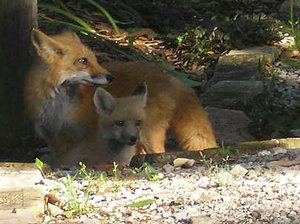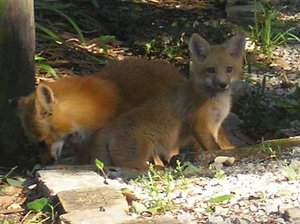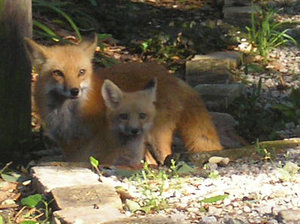The Fox Effect
/By Amy Shutt (written in December 2016)
I’ve never lived a conventional life. Things don’t happen to me in the same way or order they do for most people I know. I didn’t go to college right out of high school and graduate in four years with a degree that would guarantee me a job with benefits and a 401K. The route I chose took me 10 years before I was able to graduate college. I attended three universities and went through three majors before staying put in Philosophy. I had basically given up photography when I switched my major from it to Philosophy. Going to school for photo had unfortunately caused an aversion to the craft.
I worked and went to school mostly part-time, but pushed through full-time the past two years. During all this I was also raising my daughter on my own and had been since I was 21 years old . I worked 14 hour days on my online retail business and it was doing fairly well.
In the spring of 2007 I was running my business from home and it was doing well enough that I eventually needed more space. After many years of living in a tiny garage apartment I finally had the means to move into a real house. It was still a rental but this was a real house on a lake near the university, and perhaps one of the most picturesque neighborhoods in this city.
I chose the house because it was built in the late 1930s and there were heirloom bulbs in the messy cottage garden. I recognized the gladiolus flowers were a variety from the 1940s and the walking irises were just as old, probably passed along from a neighbor. I also chose the house because I could look out the kitchen window and see cormorants, herons and egrets on the lake through early blooming camellias that dotted the long rolling back yard. I’d always lived near water and I was excited to continue the trend for my daughter. Waterways, ponds, and lakes in Louisiana mean birds, turtles, and other fantastic critters-the kinds of things that just feel like home to me.
We had been living in the new house a month so far so we were still busy settling in and unpacking. One gorgeous Louisiana spring afternoon as we headed home, I drove into our neighborhood and as I turned the corner only a block from our house my daughter pointed and yelled, “Mom, I just saw a fox!”. I instantly slammed on the breaks and looked back; she was right. There to my left sitting in the drainage ditch between the street and the sidewalk was an adult fox. Her copper fur shown like tiny blazes of fire in the late afternoon light as it filtered through the Live Oak tree canopy above. I backed my car up slowly and stopped when we were eye to eye with her. She just stared at us; she didn’t budge. To this day I think she was the tamest, or boldest, fox I’ve ever come across.
I was locking eyes with something that looked and felt so much like a domestic dog, until I noticed her thin vertically oriented pupils. They were more cat-like than canid. At that moment I didn’t know why her pupils were shaped like that, but I saw the wildness of that animal in a way I’ve never seen it in an animal before or since. I couldn’t look away; I was completely transfixed.
Later I would learn that the shape of the fox’s pupil and the degree to which they can close down or open them is what allows them to see in dim light; its an important feature since they are largely nocturnal. Not only that, vertically oriented pupils help predators who hunt ambush style, those who hide until they attack their prey from a close distance. The pupil shape allows them to judge distance without moving their head, which for an ambush predator is vital to avoid detection from their prey. We stared each other down for a few more seconds before she very calmly disappeared into the drainage pipe.
I quickly drove home to grab my camera. All my film cameras were boxed away so all I kept around was a point and shoot that could fit in a coat pocket. Armed with my tiny camera, I pulled the car up next to the drainage pipe and out popped the adult fox. And then to our surprise out popped a fox kit too! The kit was just as bold as the mom and she looked at us curiously, sniffing the air. We watched them for a couple of minutes then they disappeared into the pipe. I took three snapshots that day.
Evening walks soon led us to the den. The fox family was making their home just a few blocks from our home underneath an old uninhabited but maintained house. The house faced the lake and was on a rather busy road, but the foxes largely used the drainage pipes to navigate the area. I remember one morning just after sunrise we drove past the fox house and noticed a small traffic jam caused by the sight of the kits playing rambunctiously outside of their den. As I slowly drove past a man in a truck opposite of me asked, “Can you believe this? Amazing isn’t it?” I smiled and nodded my head. Yes, it was quite an amazing sight.
People seemed to really enjoy this little mini-view into the wild on their way to work or school. Taking in the entire scene made me smile, but I remember being a bit concerned for their well-being at the same time. It seems for every one person who welcomes urban wildlife there is another who feels the opposite and who might be capable of trying to have the animal removed and “relocated”. The problem with this is two-fold. Removing and relocating or trapping and killing an animal from an environment just opens up the space for another animal to move in, and if the population is healthy, one will. Both of these options have always seemed pointless to me. Also, animals are territorial. Relocating an animal could dump it into another animal’s territory, immediately causing conflict.
About a week after we discovered the den location, my daughter and I sat down at the bottom of the fox house driveway at dusk to watch the fox family emerge from under the house. We sat about 15 feet from each other and kept a good distance from the den entrance. One by one they slowly started to emerge. Mom fox noticed us immediately but kept a distance and just watched us watching her babies, who ran and romped and played and chirped. The bolder kit of the litter soon took notice of my daughter, looking curiously and sniffing the air as he made his way towards her. The others followed soon after. At the time my daughter had long hair down to her waist and she used a fruit-scented shampoo. I wondered if the fruity scents of her freshly washed hair is what drew them to her.. They got closer and closer and eventually their little noses were an inch from her hair and for 20 seconds there was my daughter with a garland of coppery little foxes wrapped around her. The one thought that keep going through my mind was, ‘Why don’t you have a camera with you?’ They eventually lost interest and went back to their romping and running. My daughter was 11 at the time and I know it was an experience she’ll always remember.
After that, I remembered to bring my point and shoot with me on our next early evening walk. Keeping distance and watching to make sure I wasn’t making mom fox uncomfortable or nervous, I shot off a few pictures to document the family. The pictures are awful because of the low resolution of the tiny camera and with bad lighting it couldn't correct for, but they are still some of my favorites captured moments. They represent the last time I saw the fox family. Neighborhood talk was that the couple to the left of the fox house had them trapped and removed. I’ll never know if that happened, or if they were run off from the den, but either way we never saw them again.
The pictures (shown above) also represents a very pivotal moment in my life and it’s why I feel I owe so much to the fox. After I took those snapshots that day I uploaded them to an online forum I used to journal and speak to friends on. The first response was from a Russian photographer friend of mine, “Oh these do these creatures no justice. Go and get your cameras out of storage, stop being stubborn, and start shooting again” was the gist of what he typed to me that day. And I remember thinking that he was off the mark because I was just shooting the foxes in a documentary fashion and it didn’t matter. However, I knew deep down it did matter. It mattered in the sense that I gave up something that once gave me great joy and happiness. I gave up the one thing I never got bored with and the one thing I was always hungry to learn more about. It wasn’t just a disservice to the foxes but it was a disservice to myself too. I was being stubborn and getting in my own way.
I vowed that day to start shooting again. It meant a lot at the time because I had yet to make the DSLR leap from film. I was a purist and had resisted it for some time. But that day it all became clear, and I started saving up for my first DSLR. Had none of these experiences happened, had I never moved to that house, had I never seen those foxes, I would not be doing what I do today. Photography would not be a part of my life. And yes, I came back to it in a roundabout unconventional way and “late” comparatively speaking, but as I mentioned early on--nothing I do seems to be the result of conventions. I follow my heart more often than my logic, which can sometimes result in a little bit of magic in my life.
Sometimes when I am with students at a workshop or they tell me how much they have fallen in love with photography or nature having gone through my basic photography class, a little picture of the fox family pops up in my mind. Over the past 4 years, I’ve taught hundreds of students and I wonder if I’d never had the pleasure of meeting the fox family if, photographically speaking, my students would be doing what they are doing today.
It makes me think of the term butterfly effect, with reference to chaos theory, which is defined as “the phenomenon whereby a minute localized change in a complex system can have large effects elsewhere”. It’s not exactly the same thing, but taking from the general idea I’ve come to call all of this The Fox Effect. There are undeniable links and connections to foxes in my life and to the people around me. This new photojournalistic project of mine on canids that I’ve been formulating in my mind for almost a year now is a tribute to these inspirational creatures we call foxes and their canid relatives. It is about this effect they have had on my life and those who come into contact with them in some capacity. I hope you follow along.




